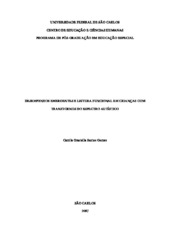Desempenhos emergentes e leitura funcional em crianças com transtornos do espectro autístico

Visualizar/
Data
2007-12-14Autor
Gomes, Camila Graciella Santos
Metadata
Mostrar registro completoResumo
People with autism display a number of marked deficits in communication, symbolic or
imaginative activities, reciprocal social interaction and the presence of a pattern of restrict
behavior. Follow-up studies indicate that people with autism show difficulties in learning
relationships between stimulus through conventional interventions. The first study assessed
the performance of twenty persons with autism in an identity matching-to-sample task, using
two procedures with different stimuli arrangements and different response requirements. The
typical matching procedure presented one sample and three comparison stimuli; the adapted
matching displayed three samples and three comparison stimuli simultaneously. The average
scores of correct performance were significantly higher under the adapted matching than
under the typical matching, but the inter-individual variability was large and the adapted
arrangement favored mainly the performance of participants with lower scores. The second
study investigated the emergence of performance that had not been directly taught to autistic
children. Four children with autism learned to match one-element comparison stimuli to twoelement
sample stimuli, in adapted matching-to-sample tasks. They also learned to name
pictures. It was used a multiple baseline design. Relations between pictures and printed words
and identification/nomination of printed words had been tested and the outcomes indicate the
emergence of performances that had not been directly taught and the formation of stimulus
equivalence classes. The dataset suggests the importance of the organization of stimuli in the
tasks and the teaching of arbitrary relations as part of the conditions to promote the
establishment of symbolic behavior in people with autism